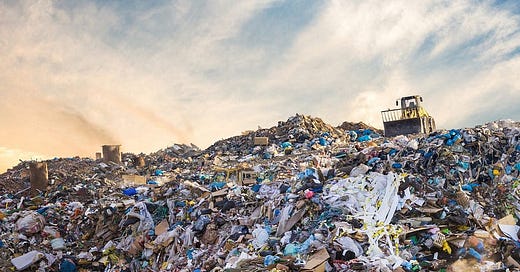
Driving through West Virginia last fall, and seeing “Almost Heaven” roadway signs juxtaposed with roadside garbage, I was struck by the irony that people who think of their state as “almost heaven” would throw trash out their car windows. “Is there litter in heaven?” I wondered. “And, if so, who picks it up?”
It’s not just West Virginia, of course. My small town in Maine also has more than its share of litter. If I walk 50 yards down the road, I see plastic bottles and beer cans that have been tossed out of cars. At a town park, I might find a plastic bag from a fast food restaurant containing half-eaten food together with the wrappings.
More than a few back roads in our town have become unofficial dumps where people offload old tires, sofas, and refrigerators, leaving them to slow decay and rust amidst the moss-covered stones.
Then there are the domestic garbage gyres, the shanties where the inhabitants hoard trash and increasingly live within a circle of garbage. A circle that expands for months or years until the inhabitants abandon it, leaving the town to pay for the cleanup.
Looking at it one way, the world is split between litterers and non-litterers. To non-litterers, littering is baffling: an archaic remnant of a bygone era, a manifestation of a persistent Cro-Magnon gene.
That’s not the story I’m writing. As I began to see when writing about the microplastics crisis, and as see more clearly now, flagrant litterers are only part of a much bigger problem.
Litterers are people who don’t know what to do with their trash, are so overwhelmed they can’t deal with it, or aren’t convinced it makes a difference. If you squint a little, they’re not so different from you and me.
A reminder of unpleasant truths
Litterers are not that different from the rest of us. What we do in private, they do in the plain light of day. That may be the biggest difference between chronic litterers and everyone else.
If I were a performance artist determined to make a political statement about the global waste problem, I might do something similar to what litterers do. I might choose a loved public space and create a heap of rusted metal, broken containers, tangled cables, soiled cardboard, and torn plastic. The only difference being I would clean up after myself afterward.
My purpose would be to bring my audience face-to-face with our waste problem. “What waste problem?” You might ask. The one in which the average American generates 1,800 lbs of waste per year. That’s 142,200 lbs. in a lifetime. (Globally, those numbers are 600 lbs. yearly and 42,000 lbs. over a lifetime.) That’s regular trash alone. These totals don’t even account for large items like desktop computers, refrigerators, couches, or cars.
The problem is that we’ve become increasingly insulated from waste disposal — and what happens to our trash once it leaves our sight.
Just as the livestock industry insulates us from the grisly business of killing and carving up our supper, our trash removal and sanitation systems insulate us from the unpleasant facts of our garbage.

Being insulated from the facts doesn’t change the facts.
We sort, separate, and curate our trash. We sequester it into perfumed two mil plastic bags. We stash it by the curb to be picked up by a $60,000-per-year sanitation worker in a $400,000 trash collection truck. These efforts to sanitize and civilize don’t change the essence of what we’re doing. It’s still garbage. We send it out of sight, but it becomes an unsightly problem somewhere else.
Imagine that instead of putting your trash on the curb you put it on a giant conveyor belt. Imagine some of the trash on the belt goes to an incinerator where it is burned and contributes to air pollution. Imagine some of the trash goes to a landfill where it leaches toxins and microplastics into the groundwater. Imagine a final portion of the trash is conveyed overseas to be added to a garbage mountain that is picked through by children and from where wind and flooding wash it into rivers and oceans.
If you imagined all this about your trash, would you still put it on the conveyor belt?
Yes. The answer is, you absolutely would. You would, because unfortunately, there’s no other place to put it.
Little trash and no litter
When I lived in a village in West Africa for two years as a Peace Corps Volunteer, I found myself on the other side of the litter issue.
I lived with no electricity or refrigeration. Food was locally sourced and locally prepared. Packaging was non-existent — unless you count a reusable nylon sack used to carry rice or a cotton cloth used for vegetables.
Empty evaporated milk cans became containers and measuring cups. Glass jars became storage bins. Plastic bags were re-used. Printed material became a toiletry item.
In the entire village, there was virtually no trash. Even husks, peelings, or rare discards were eaten by chickens or goats.
After living there for more than a year, I accumulated an armful of non-compostable, inorganic trash — a few spent flashlight batteries, an old toothbrush, and a handful of sent Bic pens. Rather than let those items remain in my house, I decided to remove them. The question was where. There was no dump. When I asked, I was told there were small discard piles on the outskirts of the village. Mostly organic items. Brush, things even the chickens and goats didn’t want. A few rusted cans. I guiltily left my few items, hoping no one would notice. Later that day, I was embarrassed to see children using my discards as toys.
The fact that I was a litterer in that instance didn’t indicate a lack of respect for the local environment or community. The fact is I had no choice. There were no garbage bags and no organized recycling. There was no “transfer station” or official town dump. There was no “away” for me to throw things to.
Small world
In an agricultural, pre-industrial society without manufacturing, packaging, and transportation systems, there is much less waste, and what waste there is, is largely biodegradable.
Things have changed mightily since the beginning of the industrial revolution. The world population is eight times larger. The global accumulation of garbage is exponentially larger. The biggest change, of course, is that so much of our trash is non-organic. So much of it is slow to decompose— and when it does break down, it releases toxins that are harmful to plants, animals, and humans.
Our understanding of how air, water, and soil pollutants affect us and other living creatures has increased. Our ethical understanding, also, has increased. We no longer excuse the degradation of ecosystems, even ones that we have no use for. Indigenous and marginalized peoples — and plants and animals too — have rights. The places where they live are no longer fair game for our trash.
What this all adds up to is this: no longer is there an away to throw things to.
A return to zero waste
If drink containers and food packaging could be designed to decompose into organic materials within ten minutes of being left on the ground, the problem of littering would be instantly solved. That‘s a tech fix we’ll probably never see, unfortunately. This thought experiment does, however, point out that littering is a materials and design problem as much as it is an end-user problem.
In other words, it’s not fair to entirely blame the litter problem on people who don’t pick up after themselves. It’s not fair to entirely blame the global trash problem on consumers. There’s a great deal of work to do on the product design and packaging end — and the good news is that this work is already taking place.
Companies such as Amcor, Notpla, and Evocative are designing and producing packaging made from biodegradable materials including compostable paper, seaweed, and mycelium.
Fast-food chains including McDonald’s and Burger King have committed to 100 percent recyclable packaging from sustainable sources. Their goal includes eliminating the use of single-use plastics and materials containing PFAS.
Manufacturers of products from laptops to automobiles are reducing waste and putting more thought into end-of-life. For example, laptops are being designed to be easily dissembled, making recycling easier and more cost-effective. Tech companies such as Acer are making products that can be more easily repaired and upgraded. Carmakers are integrating end-of-life into their design process, making it easier and more cost-effective to recycle batteries and to recover and recycle materials such as steel, aluminum, and plastic.
These changes represent a move in the right direction, but we have a long way to go, and we each need to play a part. Especially when it comes to toxic and non-biodegradable materials, reducing waste is not enough. Waste needs to be eliminated — because there’s no good place to put it. All land is valuable. We can’t afford to degrade more of it with toxic materials. The health of our oceans is already threatened. We can’t afford to add to the microplastics already in them.
This is not about guilt or despair; it’s about empowerment and hope. By embracing conscious consumption, supporting sustainable businesses, and advocating for needed change, we can create a future where waste is a relic of the past.
Wasting less builds a different kind of wealth — a wealth that comes from the satisfaction of doing the right thing. A wealth that comes from respecting the other living beings we share this planet with, and for those who will come after us.
We all are litterers, but we can also all be part of the solution.





Amen. We need to move upstream to figure this out.
Thank you Ray. Very informative as always. Our overconsumption only exacerbates the problem.